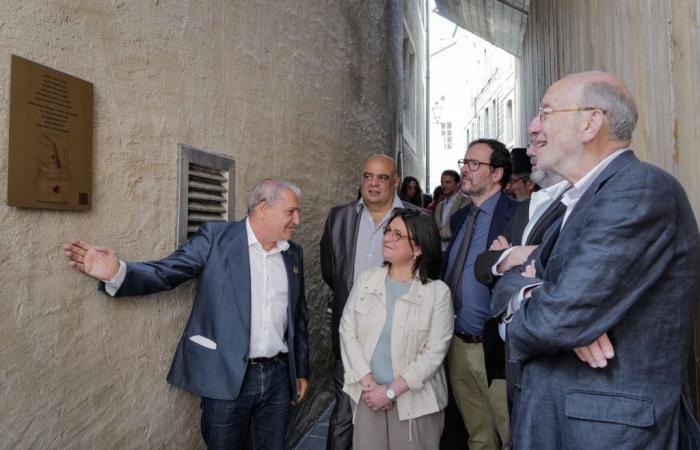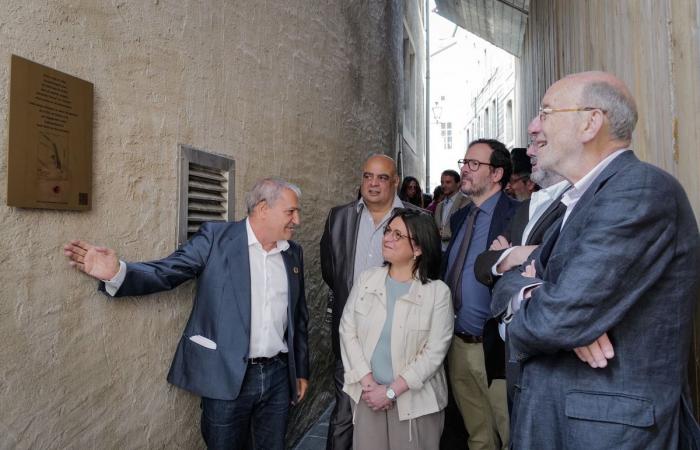– “Geneva created the prototype of the Jewish ghettos of Europe”
In the 15the century, the Jews had to confine themselves to one district, the Cancel. The City recalls this little-known piece of history.
Published today at 5:35 p.m.
Geneva, June 17, 2024. In the small rue Marcelle-de-Kenzac, in the Old Town, administrative councilor Alfonso Gomez inaugurates the epigraphic plaque in memory of the Cancel of Geneva, in the presence of Roseline Cisier, president of the Jewish Community of Geneva.
LAURENT GUIRAUD
Subscribe now and enjoy the audio playback feature.
BotTalk
Who has heard of Geneva Cancel? The story remains unknown to most people. However, it deserves to be remembered: Cancel is the district of the Old Town where Jews were forced to reside from 1428 to 1490, the date of their expulsion. An epigraphic plaque was placed this Monday not far from this enclave to recall its existence.
It took years to achieve this official recognition. In 2016, municipal councilor Sylvain Thévoz tabled a motion “so that Geneva honors the memory of one of the oldest ghettos in Europe”. The Municipal Council adopts it in 2021 and it will take another three years to arrive at the installation of this plaque, at the end of the narrow rue Marcelle-de-Kenzac, perpendicular to the Grand-Rue and the rue des Granges.
We can barely see it, in this alleyway cluttered with scaffolding, located outside the Cancel perimeter. “Be sure that we will initiate all requests from the various owners so that this plaque is soon placed where it should be, on the Place du Grand-Mézel,” promised administrative councilor Alfonso Gomez.
“We must not try to water down the story”
Through this gesture, the City – which commissioned the historian Sarah Pflug to shed light on this episode in Geneva’s history – intends to recall its “firm opposition to any discrimination that Jewish people and any individual would suffer because of their origin , his nationality, his culture or his beliefs”. A gesture appreciated by the Jewish community represented on Monday by CICAD, the Jewish Community of Geneva and the liberal Jewish community of Geneva.
“We must not try to sugarcoat the story, we are talking about cancel – from the Latin cancelus, barrier, closed place – but it is the prototype of Jewish ghettos in Europe,” underlines Jean Plançon, who wrote two books on the history of the Jews of Geneva. For this self-taught historian, although the term “ghetto” appears with that of Venice in 1516, the Cancel of Geneva is analogous in many points: “The coercive measures, progressively limiting the freedom of movement or the exercise of certain professions, will be accompanied by vexatious measures, such as the compulsory wearing of a distinctive sign, the rouelle; measures intended primarily to avoid any cohabitation and any sharing of a bed with Christians.”
For Jean Plançon, we should not confuse the “Jewery” – a district where Jews gathered, from 1396, on a voluntary basis – and the “cancel”, established in 1428 on a more restricted area and closed by two doors. This hardening foreshadows others, until the expulsion of “some 200 people” in 1490. “The Jews had five days to leave, leaving everything behind them. Their property was robbed.”
“Latest news”
Want to stay on top of the news? “Tribune de Genève” offers you two meetings per day, directly in your email box. So you don’t miss anything that’s happening in your canton, in Switzerland or around the world.To log in
Sophie Davaris is deputy editor-in-chief of the Tribune de Genève where she has worked since 2000. She is particularly interested in local news and public health. More informations
Did you find an error? Please report it to us.







